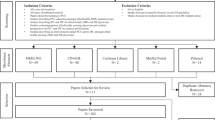Abstract
BACKGROUND
Traditional residency training may not promote competencies in patient-centered care.
AIM
To improve residents’ competencies in delivering patient-centered care.
SETTING/PARTICIPANTS
Internal medicine residents at a university-based teaching hospital in Baltimore, Maryland.
PROGRAM DESCRIPTION
One inpatient team admitted half the usual census and was exposed to a multi-modal patient-centered care curriculum to promote knowledge of patients as individuals, improve patient transitions of care, and reduce barriers to medication adherence.
PROGRAM EVALUATION
Annual resident surveys (N = 40) revealed that the intervention was judged as professionally valuable (90%) and important to their training (90%) and offered experiences not available during other rotations (88%). Compared to standard inpatient rotation evaluations (n = 163), intervention rotation evaluations (n = 51) showed no differences in ratings for traditional medical learning, but higher ratings for improving how housestaff address patient medication adherence, communicate with patients about post-hospital transition of care, and know their patients as people (all p < 0.01). On post-discharge surveys, patients from the intervention team (N = 177, score 90.4, percentile ranking 97%) reported greater satisfaction with physicians than patients on standard teams (N = 924, score 86.1, percentile ranking 47%) p < 0.01).
DISCUSSION
A patient-centered inpatient curriculum was associated with higher satisfaction ratings in patient-centered domains by internal medicine residents and with higher satisfaction ratings of their physicians by patients. Future research will explore the intervention’s impact on clinical outcomes.
Similar content being viewed by others
REFERENCES
Institute of Medicine. Committee on Quality of Health Care in America. Crossing the quality chasm: a new health system for the 21st century. Washington DC: National Academy Press; 2001:337.
Accreditation Council on Graduate Medical Education. Common program requirements: General competencies. 2007. Available at: http://www.acgme.org/outcome/comp/generalcompetenciesstandards21307.pdf. Accessed August 31, 2011.
Ratanawongsa N, Rand CS, Magill CF, et al. Teaching residents to know their patients as individuals. The Aliki initiative at Johns Hopkins Bayview Medical Center. Pharos Alpha Omega Alpha Honor Med Soc. 2009;72(3):4–11.
Record JD, Rand C, Christmas C, et al. Reducing heart failure readmissions by teaching patient-centered care to internal medicine residents. Arch Intern Med. 2011;171(9):858–9.
Ludmerer KM. Redesigning residency education-moving beyond work hours. N Engl J Med. 2010;362(14):1337–8.
Steinbrook R. The debate over residents' work hours. N Engl J Med. 2002;347(16):1296–302.
Reed DA, Fletcher KE, Arora VM. Systematic review: association of shift length, protected sleep time, and night float with patient care, residents' health, and education. Ann Intern Med. 2010;153(12):829–42.
Arora VM, Georgitis E, Siddique J, et al. Association of workload of on-call medical interns with on-call sleep duration, shift duration, and participation in educational activities. JAMA. 2008;300(10):1146–53.
McMahon GT, Katz JT, Thorndike ME, Levy BD, Loscalzo J. Evaluation of a redesign initiative in an internal-medicine residency. N Engl J Med. 2010;362(14):1304–11.
Suchman AL, Matthews DA. What makes the patient-doctor relationship therapeutic? Exploring the connexional dimension of medical care. Ann Intern Med. 1988;108(1):125–30.
Bray-Hall S, Schmidt K, Aagaard E. Toward safe hospital discharge: a transitions in care curriculum for medical students. J Gen Intern Med. 2010;25(8):878–81.
Wiecha JM, Markuns JF. Promoting medical humanism: design and evaluation of an online curriculum. Fam Med. 2008;40(9):617–9.
Matter CA, Speice JA, McCann R, et al. Hospital to home: improving internal medicine residents' understanding of the needs of older persons after a hospital stay. Acad Med. 2003;78(8):793–7.
Lown BA, Sasson JP, Hinrichs P. Patients as partners in radiology education: an innovative approach to teaching and assessing patient-centered communication. Acad Radiol. 2008;15(4):425–32.
Liu SS. An oasis in time. Ann Intern Med. 2010;153(9):614–5.
Glickman SW, Boulding W, Manary M, et al. Patient satisfaction and its relationship with clinical quality and inpatient mortality in acute myocardial infarction. Circ Cardiovasc Qual Outcome. 2010;3(2):188–95.
Boulding W, Glickman SW, Manary MP, Schulman KA, Staelin R. Relationship between patient satisfaction with inpatient care and hospital readmission within 30 days. Am J Manag Care. 2011;17(1):41–8.
Roy CL, Liang CL, Lund M, et al. Implementation of a physician assistant/hospitalist service in an academic medical center: impact on efficiency and patient outcomes. J Hosp Med. 2008;3(5):361–8.
Meltzer D, Manning WG, Morrison J, et al. Effects of physician experience on costs and outcomes on an academic general medicine service: results of a trial of hospitalists. Ann Intern Med. 2002;137(11):866–74.
Ziegelstein RC, Rand CS, Hellmann DB. Redesign of internal-medicine teaching. N Engl J Med. 2010;363(6):594. author reply 594.
Garman AN, Garcia J, Hargreaves M. Patient satisfaction as a predictor of return-to-provider behavior: analysis and assessment of financial implications. Qual Manag Health Care. 2004;13(1):75–80.
Charmel PA, Frampton SB. Building the business case for patient-centered care. Healthc Financ Manag. 2008;62(3):80–5.
Cooke M, Irby DM, Sullivan W, Ludmerer KM. American medical education 100 years after the Flexner report. N Engl J Med. 2006;355(13):1339–44.
Irby DM, Cooke M, O'Brien BC. Calls for reform of medical education by the Carnegie Foundation for the Advancement of Teaching: 1910 and 2010. Acad Med. 2010;85(2):220–7.
Contributors
Andrew Bilderback contributed to this manuscript.
Funders
The Aliki Initiative is funded through the Johns Hopkins Center for Innovative Medicine, thanks to the generosity of Mrs. Aliki Perroti.
Conflict of Interest
None disclosed.
Author information
Authors and Affiliations
Corresponding author
Electronic Supplementary Material
Below is the link to the electronic supplementary material.
ESM 1
(PDF 83 kb)
Rights and permissions
About this article
Cite this article
Ratanawongsa, N., Federowicz, M.A., Christmas, C. et al. Effects of a Focused Patient-Centered Care Curriculum on the Experiences of Internal Medicine Residents and their Patients. J GEN INTERN MED 27, 473–477 (2012). https://doi.org/10.1007/s11606-011-1881-8
Received:
Revised:
Accepted:
Published:
Issue Date:
DOI: https://doi.org/10.1007/s11606-011-1881-8




